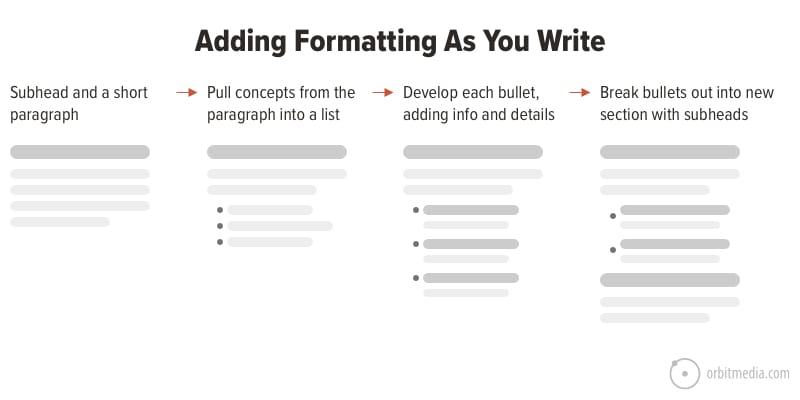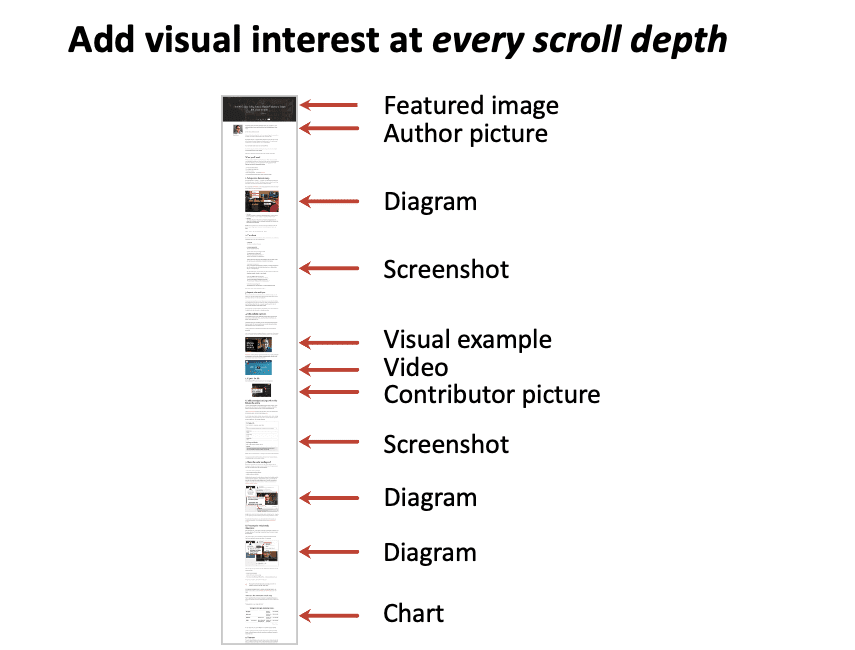There are two famous factors in the Google search ranking algorithm.
- Authority is the general trustworthiness of a website or webpage.
It is mostly a function of links from other websites.
It is affected by PR and off-site SEO. - Relevance is the page content itself.
It’s mostly a function of keywords and is topic-focused.
It is affected by copywriting and on-page SEO.
But there is a third, less famous search ranking factor that Google uses to determine the quality of a page. It’s not about links or keywords. It’s about the behavior of the visitor.
Did they click? Did they stay? For how long? Did they hit the back button?
These are all “user interaction signals.”
They’re also known as “user signals” “user experience signals” or simply “UX signals.” Whatever we call them, they are important factors for the search engine to learn if the page is satisfying or not. They are proxies for content quality.
So this is the third, key search ranking factor:
- User interaction signals are about visitor behavior.
These are a function of user engagement.
They are mostly affected by content formats, design and structure.
Let’s put them together in a chart:

Together, these factors explain the main reasons why any URL ranks or doesn’t.
- If you don’t have sufficient authority for the target phrase, you have no chance of ranking.
- If you don’t cover the topic thoroughly, the page won’t be seen as relevant for the target phrase.
- If you don’t engage the visitor quickly, poor user signals may hurt the rankings next time.
Of course, there are other, less important search ranking factors. Some are verified, others are just suspected. Here is a partial list in a big dense paragraph. This list was originally curated and fact-checked by Corey Northcutt.

Setting those aside, let’s explore user signals for SEO. We’ll start with three possible signals that Google may be using as ranking factors, then we’ll finish with practical approaches to improve your own user interaction signals.
User signal #1: Click through rate from search
Is the click through rate (CTR) from a search engine results page (SERP) a ranking factor?
Yes. For years, Google has run live experiments that evaluate the quality of search results based on the rate at which visitors click on search listings. Here is a video of Paul Haahr, a Ranking Engineer at Google, explaining the approach (and its challenges) at SMX way back in 2016.
User signal #2: Bounce rate
Is bounce rate a search ranking factor?
No. At least not from the data we see. We have access to 500+ Google Analytics accounts and the patterns are obvious and consistent. The highest ranking, highest search traffic articles often have the highest bounce rates, especially for content marketing related URLs.
Look at the data:

It makes sense that Google doesn’t see bounces as a negative user signal. A bounce is generally defined as a one-page visit. And why would a one-page visit indicate the page was unsatisfying?
They searched, they clicked, they found their answer and closed the tab. No need to visit any other pages.
Note: “Return to SERP rate” is another story. This is a back button click that brings the visitor back to Google. That’s a completely different type of bounce. We can’t separate these two types of bounces in Google Analytics, but it’s likely that Google sees this as a negative user signal.
User signal #3: Time on page from search (dwell time)
Is dwell time a search ranking factor?
Probably, yes. Google can easily answer this question: Does the visitor stay for just a few short seconds, or for several long minutes?
The difference is the “short click” vs. the “long click.”
A short click visitor from search landed on your page and quickly decided they were in the wrong place. Something about the design or content disappointed them and they hit the back button. This is known as pogo-sticking and many SEOs believe it’s bad for your rankings.

You may see evidence of this in your own data. Look at the pages that get the most traffic from search (use a quick segment in Google Analytics) and check the average time on page.
Here is what you might find:

Notice how much time the visitor spends on these pages? For the average visit to be 7+ minutes, then many visitors are spending 10-15 minutes.
How is it possible to hold your visitors’ attention for so long? Let’s answer that question.
How to keep your visitors happy (and keep your rankings up)
The key is to carefully structure the content.
Use visuals that capture attention, use formatting to help people scan through, and finally, give them enough depth and detail to pull them down the page. These tactics go beyond the technical factors of core web vitals and page experience and into the content itself.
1. Greet them with a friendly face
You have a split second to make a first impression. What’s it going to be? A stock photo? A popup window? Or a friendly smile?
Adding a picture of the face of the author instantly makes the post more approachable. Faces are uniquely engaging, in any context. In a blog post or around the dinner table.

Unfortunately, just 63% of blog templates show the face of the author. If short clicks and low dwell time are search ranking factors, this design decision could be bad for SEO.
ProTip: Don’t show dates. If your content is evergreen, the date just makes it look older sooner. If the visitor sees an old date, they’re more likely to quickly hit the back button, sending a negative UX signal for the search engine. Even worse, if the search engine adds the date to the snippet in search results, they may not click at all.
2. Skip the throat-clearing language
Get right to the point, please. No need for a long preamble. If you can cut the first paragraph and the post still makes sense, do it.
There are many possible strategies that the marketer can consider, from email marketing and search optimization to influencer marketing and social media. But these days, a trend seems to be emerging about one of those key channels. So we decided that it’s time to take a closer look. What we’re seeing across many industries is that social media is about more than driving traffic.
A boring opening is bad for engagement, and low engagement is bad for SEO.
And don’t stuff the opening paragraph with keywords. There’ll be plenty of time to indicate relevance farther down in the post.
3. Make it scannable with subheads, bullet lists and numbered lists
You may think of your visitor as a “reader” but “scanner” is more accurate. Visitors from search tend to be in a hurry. They have a specific information need and they are quickly deciding if your page will help.
That’s why subheadings are critical.
The natural process of writing should lead to good subheads and lists. As an idea expands, don’t let it grow into dense blocks of text. If a paragraph mentions three things, break them out into a list.

Content needs structure.
The structure makes the content engaging.The formatting slows down the scan reader and invites them to dive into the text at the spot that’s right for them.
 |
Alex Birkett, Founder Omniscient Digital“I think a lot about how to get users to stick around. Perhaps there’s an SEO benefit, but I also just want to maximize the likelihood they’ll remember my content. One way I do that is to create guides with the intent of being unreadable in a single sitting. I want them to be bookmarked as a sort of “choose your own adventure” resource. For example, my guide on A/B testing is more of a reference checklist, but you can choose where you start based on your skill level. Another thing I do is inject video and multimedia into my content. Since we do the podcast, I can easily embed interviews with experts when it’s contextually relevant. But since I write a lot of technical/how-to content, I also love embedding a quick Loom video as a walkthrough to supplement my written word and images.” |
4. Keep your paragraphs short
As a general rule, never write a paragraph longer than three lines. Here’s why:
Short paragraphs get read.
Long paragraphs get skimmed.
Very long paragraphs get skipped.
When the reader starts skipping entire sections, soon they’ll be giving up on the page itself.
Combine short paragraphs with subheads and bullets and you can start to feel the difference. Same content, different formatting. Which of these would your visitor prefer?

Designers know that visitors love white space. But a lot of content marketers didn’t get the memo.
SEO copywriters like to add a lot of text, but if that text is dense, blocky paragraphs, they may be improving relevance while hurting user signals. Regardless of user intent, no one likes huge paragraphs.
5. Multiple images
2012: “Put a great picture on every page.”
2022: “Put a great picture at every scroll depth of every page!”
Formatting is great, but the best way to slow down the scan reader is with visuals. Use any of these types of images and you’ve made the page more interesting, at least for that scroll depth.

This post has 12 images, but who’s counting?
If the page starts to get too heavy with text, the reader has to work harder. They’re more likely to lose interest. But images are easy for the brain to process. And some images, especially diagrams and infographics, can hold the visitors attention for longer, all by themselves.
Google knows that more images mean more engagement. Year after year, search results get more and more visual. If your page is less visually engaging than the search results they came from, then the back button is that much more alluring.

6. Embed video at the top
The ultimate visual is video.
If the post is already getting traction from search, adding a video to it is an automatically successful content strategy. It will have instant visibility. The video is destined to be a hit.
But just as the post supports the video, the video also supports the post.
If you track video views using event tracking (setting in Google Tag Manager) and look at the behavior of those video watchers separately (using a segment in Google Analytics) you can see the impact on the engagement metrics.
It can be dramatic. In this example, visitors who click the play button spend 400% more time on the page.

Now you know how videos impact search rankings:
- Videos can increase time on page.
- Time on page from search (aka “dwell time”) is a user signal.
- User signals are a ranking factor.
7. Add click-worthy internal links
If they click to go to another page, they’re not going back to Google. The search engine concludes that the page met their needs.
Most SEOs know that internal links are important for passing authority between pages. They have an SEO benefit, even if they are never clicked. But internal linking can also increase engagement and reduce the risk of weak user signals.
This only works if the visitor actually clicks the link.
So rather than just make simple little boring links, using only keywords as anchor text, work harder on your internal links. Make each a mini call to action. Make them compelling, specific or unexpected. Every click on those links is one less click on the back button.
8. Write long, detailed, complete articles!
There is a lot of research that shows a correlation between content length and rankings. I know of at least four major studies that show this connection.
Most SEOs don’t believe that word count is a ranking factor. They believe that more content means more opportunities to indicate relevance, both for the primary keyphrase and the semantically related phrases.
But the second benefit of long-form content is to trigger user signals. Longer content tends to create longer time on page. And dwell time is a user signal for search engines.
Does longer content lead to longer visits? It’s not possible to conduct a correlation study on this without access to lots of Analytics accounts. But do some analysis using your own data and you may see the connection.
Here’s a scatter plot chart showing the relationship between word count and time on page for this website. It’s clear: longer content leads to longer visits.

Now you have another reason to go deep into your topics. Make it detailed, even exhaustive. Build high-quality content that covers the topic from every angle. Answer all the related questions. Dive into the subtopics. Make it complete and do it for your visitors, not an algorithm.
9. Write a high CTR title tag
Our last tip helps send the first user signal: the click!
The title tag is usually the link in the search snippet when the page ranks. If it catches their attention and gives them a good reason to click, you’ll send a positive user signal to the search engine.
Yes, the title tag needs to include the target phrase and stay under 65 characters. But that’s not all. A high CTR title usually has one or more of the following attributes.
- Strong benefits
It highlights the value of the article and makes a specific promise.
Example: “Complete step-by-step guide to improving user signals for SEO” - Low investment
It indicates the article is scannable, visual or otherwise, easy to consume.
Example: “Improving user signals: 10 quick ways to keep visitors engaged” - It’s different (or weird)
It catches attention with a weird or unexpected word.
Example: “Want better user signals for SEO? This is how Jay-Z would do it”

These are no different from the headline best practices used by content marketers in social media and email marketing. Headlines are the key to every channel in digital marketing.
UX is SEO
We hope that this was a good reminder to keep a sharp focus on the fundamental reason for having pages of content in the first place: the visitor.
- For the SEOs who think UX is someone else’s job, this is your wake-up call. User experience (as measured as dwell time by Google) is important for your rankings.
- For the UX pros and writers who think SEO was just keywords and links, this is a reminder that you have a seat at the ranking table too.
Google knows if you’re satisfying the visitor’s search intent if you’re answering the user’s query. They know the user behavior. And those page experience signals are part of the Google algorithm, the same way social signals drive social media algorithms.
And now you know how to improve the signals your visitors are sending to Google.




